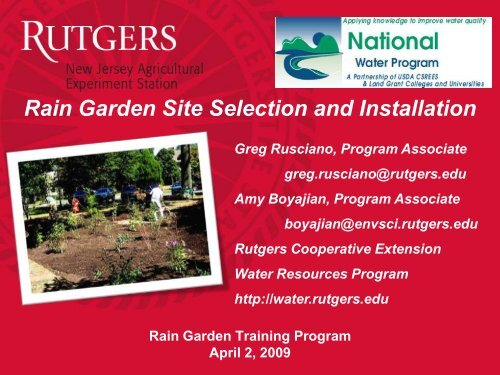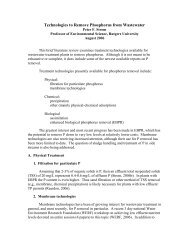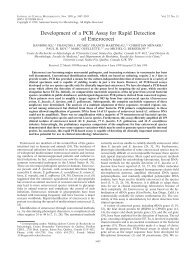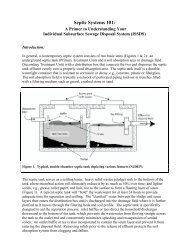Rain Garden Site Selection and Installation - Rutgers Cooperative ...
Rain Garden Site Selection and Installation - Rutgers Cooperative ...
Rain Garden Site Selection and Installation - Rutgers Cooperative ...
- No tags were found...
You also want an ePaper? Increase the reach of your titles
YUMPU automatically turns print PDFs into web optimized ePapers that Google loves.
Frederick County<strong>Rain</strong> <strong>Garden</strong>• A rain garden was constructed at Hedgebrook Farm in 2008• GOAL: To have the rain garden serve as a demonstration for county residentswho are interested in controlling polluted runoff <strong>and</strong> to help recharge thegroundwater
What is a <strong>Rain</strong><strong>Garden</strong>?• Shallow l<strong>and</strong>scapeddepression that treatsstormwater runoff.• Designed to merge twoimportant goals: aesthetics<strong>and</strong> water quality• Can be blended into thel<strong>and</strong>scape <strong>and</strong> made to looknatural.• Water is directed into themby pipes, swales, or curbopenings.
Benefits• Designed to intercept, treat,<strong>and</strong> infiltrate stormwater atthe source before itbecomes runoff• Provides very high pollutantremoval efficiencies• Can be incorporated intothe l<strong>and</strong>scapes of manylocations
The Parts of a<strong>Rain</strong> <strong>Garden</strong>
• Infiltration of runoff− Provides flood control, groundwater recharge, <strong>and</strong> nutrient removalThe Science Behind<strong>Rain</strong> <strong>Garden</strong>s• Absorption to soil particles− Removes dissolved metals <strong>and</strong> soluble phosphorus• Plant uptake− Removes small amounts of nutrients• Microbial processes− Removes organics <strong>and</strong> pathogens• Exposure to sunlight <strong>and</strong> dryness− Removes pathogensNOTE: 90% of all storm eventsproduce less than 1 inch of rain.Therefore, the key to reducingpollutant loads is to treat therunoff associated with the first 1inch of rain (Clayton & Schueler,1996).• Sedimentation <strong>and</strong> filtration− Removes total suspended solids, floating debris, trash, soil-boundphosphorus, some soil-bound pathogens
Infiltration of RunoffHow much water does a typical rain garden treat in a year?• 90% of rainfall events are less than 1.25”• New Jersey has approx. 44” of rain per year• The rain garden will treat <strong>and</strong> recharge:0.9 x 44” = 40”/year = 3.3 ft/year• The rain garden receives runoff from 1,000 sq.ft.• Total volume treated <strong>and</strong> recharged by the rain garden is1,000 sq. ft. x 3.3 ft/year = 3,300 cubic feet/year,which is 25,000 gallons/year• Build 40 rain gardens <strong>and</strong> we have treated <strong>and</strong>recharged 1 million gallons of water per year!
How To Install a<strong>Rain</strong> <strong>Garden</strong>
Steps3. Maintenance2. <strong>Installation</strong>1. PlanningMendham Township Elementary School, Morris County
Planning Steps• Identify <strong>Site</strong>• <strong>Site</strong> Visit1. Planning• Design Calculations
<strong>Rain</strong> <strong>Garden</strong>Placement• The rain garden should be at least 10 feet from the house soinfiltrating water doesn’t seep into the foundation.• Do not place the rain garden directly over a septic system.• Do not put rain garden in places where the water already ponds orthe lawn is always soggy.• Place in full or partial sunlight as a first option• Select a flat part of the yard for easier digging as a first option.• Avoid large tree roots.Things to Rememberhttp://clean-water.uwex.edu/pubs/raingarden/rgmanual.pdf
Determine Existing Utility Lineshttp://www.missutilityofvirginia.com/
Planning StepsIdentify <strong>Site</strong>Identify the Drainage AreaBeforeParking Lot/DrivewayRoofUnion County Vocational SchoolHockman Farm, Winchester, Virginia
AfterParking Lot/DrivewayRoofUnion County Vocational SchoolHockman Farm, Winchester, Virginia
Parking Lot/ Driveway with a Curb CutBeforeAfter<strong>Rutgers</strong> <strong>Cooperative</strong> Extension of Monmouth County, Freehold, NJ
Planning Steps<strong>Site</strong> VisitDetermine Current Stormwater FlowFlowIf the area is prone toflooding, it may bedifficult to improve thedrainage.Union County Vocational School
Planning StepsIdentify <strong>Site</strong>Identify Drainage ProblemsProperty FloodingUnion County Vocational School
Planning StepsIdentify <strong>Site</strong>Current L<strong>and</strong>scaping PracticesUnion County Vocational School
Planning Steps<strong>Site</strong> VisitMeasure Drainage AreaRoofSurface Area = (L1xW) + (L2xW)Roof= (15’x20’) + (10’x20’)= (300’) + (200’)= 500 square feetWL1L2Hockman Farm, Winchester, Virginia
Make observationsduring storms toestimate thedrainage area<strong>Rain</strong> <strong>Garden</strong>Or use surveyequipmentDrainage Area
Planning Steps<strong>Site</strong> VisitMeasure Drainage Area<strong>Rain</strong> <strong>Garden</strong> Sizing Tablefor New Jersey’s Water Quality Design StormSurface Area of ImperviousSurface to be Treated(sq. ft.) or (LxW)Size of 6” deep <strong>Rain</strong><strong>Garden</strong>(sq. ft.) or (LxW)500 sq. ft. 100 sq. ft. or 10’x10’750 sq. ft. 150 sq. ft. or 15’x10’1,000 sq. ft. 200 sq. ft. or 20’x10’1,500 sq. ft. 300 sq. ft. or 30’x10’2,000 sq. ft. 400 sq. ft. or 20’x20’
Planning Steps<strong>Site</strong> VisitDetermine SlopeSlope =H1 – H2x 100 =9” – 3”=0.75’ – 0.25’x 100 = 5% slopeL10’ 10’
Determine SlopePlanning Steps<strong>Site</strong> VisitThe depth of your rain garden depends upon the slope of your lawn.Slope<strong>Rain</strong> <strong>Garden</strong> Depth< 4% 3” – 5”5% – 7% 6” – 7”8% – 12% 8”> 12% Consider Another Location
Percolation TestSteps:Planning Steps<strong>Site</strong> Visit1. Dig a hole 12 inches deep by 6 inches in diameter.2. Fill hole with water <strong>and</strong> let st<strong>and</strong> until all the waterhas drained into the ground.3. Refill the empty hole with water again. Measure thedepth of water with a ruler.4. Check the depth of water with a ruler every hour for4 hours.5. Calculate how many inches of water drained perhour.~1 inch of water draining per hour is good
Percolation TestPlanning Steps<strong>Site</strong> Visit12 34 st nd rd th HourRulerWater should be completelydrained within 24 hours.
Planning Steps<strong>Site</strong> VisitSoil Test• Sample the soil <strong>and</strong> send to the <strong>Rutgers</strong> SoilTesting Lab for:• Nutrient analysis/ recommendations• pH analysis/ recommendations• Percent s<strong>and</strong>/ silt/ clay• Soil Texture TestRoll soil into a ball in h<strong>and</strong> <strong>and</strong> see how it forms• Hard ball – Clay/Silt soil• Soft ball – Loamy soil• No ball – S<strong>and</strong>y soilGloucester County 4-H FairgroundsBut, don’t worry – clay/silt <strong>and</strong>s<strong>and</strong>y soils can be amended to getthe preferred loamy soil texture
Take PhotographsPlanning Steps<strong>Site</strong> VisitBurlington County Community Agricultural Center
Planning StepsDesign CalculationsGeneral Soil Amendments Amounts for a 100 sq ft <strong>Rain</strong><strong>Garden</strong> that is 6 Inches DeepSoil AmendmentS<strong>and</strong>CompostFertilizerLimeAmount for 100 sq ft <strong>Rain</strong> <strong>Garden</strong>1 cubic yard1 cubic yardFollow Soil Test ResultRecommendationsFollow Soil Test ResultRecommendationsGloucester County 4-H Fairgrounds
Planning StepsDesign CalculationsApproximate Amount of Plants Based on Future Mature SizeSize of <strong>Rain</strong><strong>Garden</strong>Approximate Amountof Plants100 square feet 1 Small Tree (Optional)7 Shrubs24 Herbaceous Species200 square feet 1 Small Tree (Optional)14 Shrubs48 Herbaceous SpeciesLeonard Park, Morris County
Types of PlantsPlanning StepsDesign Calculationshttp://plants.usda.govFacultative Wetl<strong>and</strong> (FACW)Facultative Upl<strong>and</strong> (FACU)Lowest Zone/Ponding AreaHighest Zone/Upl<strong>and</strong> AreaMiddle Zone/Depression AreaFacultative Wetl<strong>and</strong> (FACW),Facultative (FAC),Facultative Upl<strong>and</strong> (FACU)
Planning StepsDesign CalculationsAmount of Mulch Required fora Three Inch Thick LayerSize of <strong>Rain</strong><strong>Garden</strong>Approximate Amountof Mulch25 square feet 0.25 cubic yard50 square feet 0.50 cubic yard100 square feet 1.0 cubic yard200 square feet 2.0 cubic yardsTriple-shredded Hardwood with No DyeSpringfield Municipal Annex Building, Union County
Optional SuppliesPlanning StepsDesign CalculationsSupplies may include:• River rock• PVC pipe• Deer fencingPVC PipeRiver RockSoakerHoseSpringfield Municipal Annex Building, Union County
<strong>Installation</strong> Steps• Remove existing grass• Excavate to the desired elevation <strong>and</strong> grade• Add soil amendments• Prepare the berm2. <strong>Installation</strong>• Prepare the overflow• Level the lowest zone/ponding area• Plant the native plants• Apply the mulch• Water the native plants
Remove Existing Grass<strong>Installation</strong> StepsGloucester County 4-H Fairgrounds
<strong>Installation</strong> StepsExcavate to the Desired Elevation <strong>and</strong> GradeLeonard Park, Morris CountyGloucester County 4-H Fairgrounds
<strong>Installation</strong> StepsAdd Soil AmendmentsGloucester County 4-H Fairgrounds
<strong>Installation</strong> StepsPrepare the BermLeonard Park, Morris County
<strong>Installation</strong> StepsPrepare the OverflowOverflowGloucester County 4-H FairgroundsLeonard Park, Morris County
<strong>Installation</strong> StepsLevel the Lowest Zone/ Ponding AreaWheaton Arts <strong>and</strong> Cultural Center, Cumberl<strong>and</strong> County
<strong>Installation</strong> StepsPlant the Native PlantsCut the Root BallUlster County, New York
<strong>Installation</strong> StepsPlant the Native PlantsPlanting HoleSame Depthas Root BallUlster County, New YorkHockman Farm, Winchester, Virginia
<strong>Installation</strong> StepsApply the MulchProtect Small Plantswhen MulchingUlster County,New York
Water the Native Plants<strong>Installation</strong> StepsHockman Farm, Winchester, Virginia
Maintenance Steps3. MaintenanceShort-Term MaintenanceLong-Term MaintenanceMadeline will discuss this later…
FAQsFrequently Asked Questions• Will my rain garden cause a mosquito problem?• Will my rain garden cause flooding?• What about deer?• How do I slow down the speed of water as it enters the garden?
FAQsWill my rain garden cause a mosquito problem?• There shouldn’t be a mosquito problem if the garden isproperly sited <strong>and</strong> designed. <strong>Rain</strong> gardens shoulddrain in less than two days.• Mosquitoes have a 10 day life cycle from egg to adult.• Mosquitoes that carry most diseases do not live inponds. They prefer small amounts of st<strong>and</strong>ing watersuch as holes in trees, old tires or bird baths.
FAQsWill my rain garden cause flooding?If your rain garden does not drain out the water after ~24 hours, itis time to re-evaluate your rain garden. Maybe try:• Building berms <strong>and</strong>/or adding plants• Adding COARSE s<strong>and</strong> (not s<strong>and</strong>box s<strong>and</strong>) with organic mulchto the rain garden to help infiltrate the water
FAQsWhat about deer?Try fencing, deer resistant plants, or deer retardant sprays.New Jersey Highl<strong>and</strong>s Council Building, Morris County
FAQsHow do I slow down the speed of water as it enters thegarden?Try one or more of the following:(1) Attach a perforated plastic diffuser tothe end of your gutter/ downspout(2) Use river rock at the entrance point ofthe rain garden(3) <strong>Site</strong> your rain garden within a 10 – 15foot grass buffer between the garden<strong>and</strong> the gutter/downspout. Use nativegrasses <strong>and</strong> let them grow tall.Essex County Environmental Center
The Bottom Line• <strong>Rain</strong> gardens are designed to intercept, treat, <strong>and</strong> infiltratestormwater at the source, before it becomes runoff.• The plants are native to the region <strong>and</strong> help retaincontaminants that could otherwise harm nearby waterways.• <strong>Rain</strong> gardens are beautiful, inexpensive <strong>and</strong> lowmaintenancegardens that you can easily install at home.Linda HenryLinda HenryWoodbridge Board of Health, Middlesex County
Future <strong>Site</strong> of<strong>Rain</strong> <strong>Garden</strong>sFrederick Douglas Park, Winchester, Virginia
Any Questions?Essex County Environmental Center, Essex Countyhttp://water.rutgers.edu














